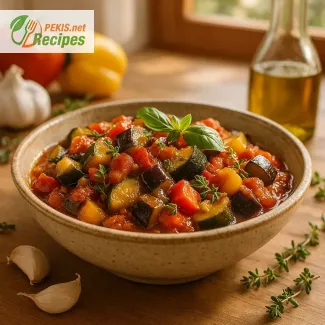
The ultimate savory pie you’ll want to master at home
Discover the elegance of homemade Quiche Lorraine with timeless French flavor
Among the most cherished dishes in French cuisine, Quiche Lorraine holds a special place as a perfect marriage of simplicity, richness, and tradition. Originating from the Lorraine region of northeastern France, this savory pie has become a culinary icon thanks to its delicate custard filling, crisp buttery crust, and irresistible smoky notes from bacon or lardons. Whether served warm or at room temperature, as a brunch centerpiece or a light dinner, this classic quiche embodies the elegance of French home cooking at its finest.
Making a homemade Quiche Lorraine allows you to rediscover the authentic flavor that often gets lost in pre-made versions. While store-bought quiches may mimic the look, they rarely achieve the same balance of texture and flavor. At home, you can ensure the pastry shell is perfectly flaky, the custard velvety smooth, and the filling proportioned to highlight the smoky depth of cooked bacon, the creamy richness of eggs and cream, and the subtle tang of nutmeg or gruyère cheese if desired. Every bite of this dish celebrates a tradition that has endured for centuries, maintaining its place at the heart of countless French family meals.
Why Quiche Lorraine is still a timeless classic
In an age of ever-evolving food trends, the enduring appeal of Quiche Lorraine lies in its versatility and accessibility. This is a dish that adapts seamlessly to casual and elegant occasions alike. It offers a luxurious texture that comes from the emulsification of eggs and cream, while its simplicity allows the quality of each ingredient to shine. The interplay of a golden, crisp crust and a custardy filling enriched with salty, smoky bacon is what makes every forkful memorable.
Another reason for its popularity is its ability to be made ahead of time. Unlike many savory pies or egg-based dishes, Quiche Lorraine tastes even better after it has rested, allowing flavors to deepen and the texture to settle. This makes it ideal not only for busy weekdays but also for hosting, as it can be served chilled, room temperature, or gently reheated without losing its charm.
Elevate your brunch table or weekday dinner
Few dishes are as universally appreciated as a well-executed quiche. With Quiche Lorraine, you're not just preparing food—you're offering a piece of French culture that invites gathering, comfort, and indulgence. It’s a recipe that has crossed borders and palates worldwide, yet still feels uniquely personal when made at home. Its elegant profile and nostalgic flavor make it a staple on brunch buffets, café menus, and home tables from Paris to California.
This tart offers something more than just taste: it invites creativity. Once the foundation of the traditional Quiche Lorraine is mastered, you can explore subtle variations—perhaps with leeks, mushrooms, or gruyère cheese—while still respecting its authentic roots. However, purists know that the true Lorraine is a minimalist marvel, relying on the harmony of just a few high-quality ingredients to deliver maximum satisfaction.
A culinary tradition worth preserving
The beauty of classic Quiche Lorraine lies in its balance. The crust should be tender yet sturdy enough to support the silky filling. The custard should be smooth and not overly eggy. The bacon should be crisped beforehand to release its full aroma and integrate beautifully without overwhelming the dish. Every element counts.
Whether you're preparing it for a Sunday brunch, a light dinner, or a special picnic, this recipe proves that French cooking doesn't have to be complicated. With just a handful of staple ingredients—flour, butter, eggs, cream, and bacon—you can create a dish that feels indulgent, elegant, and deeply comforting. The homemade version respects tradition, celebrates flavor, and connects you to a piece of culinary history that continues to delight with every bite.
- Prepare the dough:
In a large bowl, mix the all-purpose flour and salt. Add the cold cubed butter and rub between your fingertips until the mixture resembles coarse crumbs. Gradually add cold water, mixing just until the dough comes together. Shape into a disk, wrap in plastic, and refrigerate for 30 minutes. - Blind bake the crust:
Preheat your oven to 190°C (375°F). Roll out the chilled dough on a floured surface to fit a 23 cm (9 inch) tart pan. Press it into the pan and trim excess edges. Prick the bottom with a fork, line with parchment paper and fill with pie weights or dried beans. Bake for 15 minutes, remove weights and paper, and bake for another 5 minutes until lightly golden. - Prepare the filling:
In a skillet, cook the bacon over medium heat until crisp. Remove and drain on paper towels. In a bowl, whisk together the eggs, cream, and milk. Season with nutmeg and black pepper. - Assemble the quiche:
Scatter the bacon evenly over the baked crust. Pour the egg mixture over the top, ensuring it’s evenly distributed. - Bake the quiche:
Reduce oven temperature to 180°C (350°F). Bake for 30–35 minutes or until the center is set and slightly golden on top. Let cool for 10–15 minutes before slicing.
Creative ways to enhance the flavor and nutrition of Quiche Lorraine
Small changes that make a big difference in this timeless French tart
Quiche Lorraine is a well-established classic, but even traditional recipes leave room for interpretation and improvement. With just a few thoughtful adjustments, you can elevate its flavor, texture, and nutritional profile while still preserving its authentic character. Whether you're looking to make it lighter, more robust, or simply different, there are many ways to refine this dish to match your preferences and dietary needs.
Choosing better ingredients for deeper flavor
One of the most impactful ways to improve Quiche Lorraine is by upgrading the core ingredients. Instead of basic store-brand items, choose high-quality butter, organic cream, and free-range eggs. These small choices significantly enhance richness and mouthfeel. Fresh farm eggs, for example, have more vibrant yolks, which lead to a custard with better color and a fuller taste.
For the bacon or lardons, opt for thick-cut smoked bacon or artisanal pancetta. These cuts have more complexity and a firmer bite, adding a more luxurious texture. For extra depth, you can briefly caramelize the bacon with a touch of shallot or garlic, which brings a sweet-savory base to the filling without overpowering it.
Enhancing the crust for better texture
While the classic crust is made from flour, butter, water, and salt, you can intensify its flavor and flakiness by using a mix of all-purpose and whole wheat flour. A ratio of 80:20 adds nuttiness and fiber without making the crust too dense. For a truly tender crust, refrigerate the dough twice: once after mixing and again after rolling it into the tart pan. Blind baking is also essential to avoid sogginess; some even brush the crust with a beaten egg white before pre-baking to create a barrier that seals moisture out.
Subtle additions that respect tradition
Though Quiche Lorraine is traditionally minimal, you can add subtle enhancements that still align with its spirit. A small amount of gruyère or comté cheese adds a nutty complexity without turning it into a general cheese quiche. Incorporating finely chopped leeks or spring onions can introduce gentle aromatics that complement the smokiness of the bacon.
For those who appreciate herbal notes, try adding a pinch of fresh thyme or chives. These herbs pair beautifully with the richness of the custard and bring a touch of freshness. Use herbs sparingly to keep the focus on the bacon and custard balance.
Making it lighter without sacrificing flavor
If you're looking to reduce the fat or calorie content, Quiche Lorraine can be adjusted with great results. Use light cream or a blend of milk and Greek yogurt instead of heavy cream. This reduces overall richness but maintains creaminess when properly whisked with the eggs. Replacing half of the eggs with egg whites also works well to lighten the texture.
Switching out bacon for turkey bacon or smoked tofu can cut down on saturated fat while still providing a savory note. These alternatives are especially suitable for those watching their cholesterol or avoiding pork.
Gluten-free and dairy-free alternatives
To make a gluten-free version, use a crust made from a gluten-free flour blend or a base of almond flour and oat flour. These options create a flavorful base with a slight crunch. Add a pinch of xanthan gum to improve the elasticity of the dough.
For a dairy-free filling, substitute cream with unsweetened coconut cream or oat cream, and use plant-based butter for the crust. Choose a dairy-free cheese alternative that melts well or skip the cheese altogether for a more traditional filling. If you avoid eggs entirely, use silken tofu blended with a bit of cornstarch and nutritional yeast to mimic the custard texture and add umami flavor.
Common mistakes and how to avoid them
The most frequent error when making Quiche Lorraine is underbaking or overfilling the tart. The filling should be just enough to reach the top of the crust without spilling over during baking. To check doneness, gently shake the pan—only the very center should have a slight jiggle.
Another mistake is using ingredients that are too watery. Avoid adding raw vegetables directly unless they are pre-sautéed to remove moisture, as excess liquid will compromise the set of the custard. Likewise, be sure to drain bacon well on paper towels to prevent greasy residue.
A third mistake is skipping the blind bake, which results in a soggy bottom crust. Always blind bake the crust until lightly golden before pouring in the filling. This crucial step ensures a crisp and satisfying bite every time.
Bringing out more umami and aroma
To deepen flavor even more, incorporate umami-rich ingredients in moderation. A teaspoon of miso paste, stirred into the egg mixture, brings an incredible savory layer. Similarly, a dusting of parmesan or a few drops of Worcestershire sauce can amplify taste without making the tart feel overloaded.
To enhance aroma, consider roasting the bacon pieces with rosemary or sage beforehand. These herbs not only infuse the meat but release oils that make the kitchen smell incredibly inviting.
Serving suggestions and presentation tips
For an elevated presentation, serve the quiche with a light frisée salad, dressed in a mustard vinaigrette. This balances the richness with acidity and texture. You can also garnish the top with a light sprinkle of chopped herbs or a crack of black pepper just before serving for a rustic but refined look.
If you're planning to make it in advance, allow the quiche to cool completely, then refrigerate. It reheats beautifully in the oven at 160°C (320°F) for 10–15 minutes, covered with foil to prevent over-browning.
With small changes, Quiche Lorraine transforms from a classic into a signature dish. By focusing on ingredient quality, smart substitutions, and precise technique, every homemade version can become more flavorful, health-conscious, and tailored to your taste.
Allergens present in the recipe:
- Gluten (from all-purpose flour)
- Dairy (butter, cream, milk)
- Eggs
- Pork (bacon)
Allergen-free substitution tips:
- Gluten-free: Use a gluten-free flour blend for the crust. Add 1 tsp of xanthan gum if not already included in the mix.
- Dairy-free: Substitute butter with vegan margarine, cream with coconut cream, and milk with oat or almond milk.
- Egg-free: Use a mixture of silken tofu (75 g per egg) or chickpea flour batter (1 tbsp chickpea flour + 2 tbsp water per egg).
- Pork-free: Replace bacon with smoked tofu, sautéed mushrooms, or plant-based bacon alternatives.
- Vitamin A: 320 µg – Supports vision and immune system
- Vitamin D: 1.2 µg – Aids calcium absorption and bone health
- Vitamin B12: 1.5 µg – Essential for nerve function and red blood cells
- Calcium: 90 mg – Important for bone strength
- Iron: 1.6 mg – Contributes to oxygen transport in blood
- Potassium: 180 mg – Supports muscle function and fluid balance
- Magnesium: 22 mg – Assists in over 300 enzymatic reactions
- Selenium: 14 µg – Protects cells from oxidative stress
- Vitamin E: 1.8 mg – Supports skin health and immune defense
- Lutein + Zeaxanthin: 200 µg – Helps protect eye tissue from sunlight damage
- Choline: 100 mg – Supports brain development and function
- Betaine: 80 mg – Aids liver function and cellular reproduction





